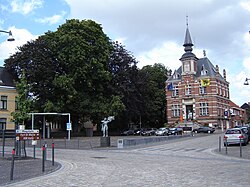Kallo | |
|---|---|
Village | |
 Square with former town hall | |
| Coordinates: 51°15′07″N4°16′42″E / 51.2519°N 4.2783°E | |
| Country | |
| Region | Flemish Region |
| Province | East Flanders |
| Municipality | Beveren |
| Area | |
• Total | 30.16 km2 (11.64 sq mi) |
| Population (2021) [1] | |
• Total | 2,442 |
| • Density | 81/km2 (210/sq mi) |
| Time zone | CET |
Kallo is a village and deelgemeente (sub-municipality) of Beveren in East Flanders, Belgium. Kallo was an independent municipality until 1 January 1977, when it merged with Beveren as part of the fusion of municipalities in Belgium. [2] Most of the deelgemeente consists of harbours and industrial zones.





